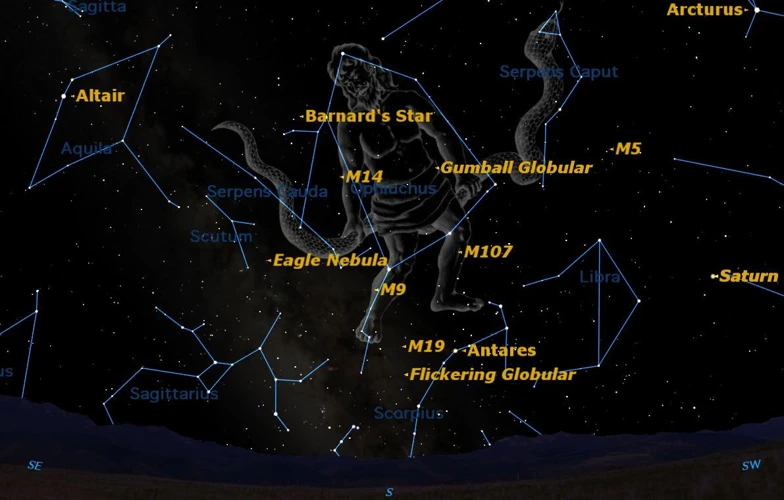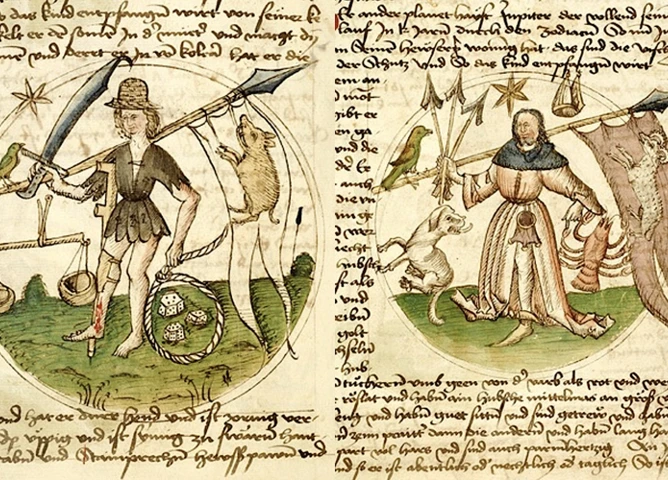Ancient civilizations have always been fascinated by the mysteries of the cosmos. One enigma that captivated their attention was the phenomenon of planetary alignments. These alignments, where celestial bodies come into an arrangement in the sky, held great significance for ancient cultures. The importance of planetary alignments can be understood through their impact on various aspects of ancient society, including cultural beliefs, architectural practices, and astrological and astronomical studies. From the alignment of sacred structures and ancient cities to the role of alignments in astrology and the quest for cosmic harmony, the influence of planetary alignments on ancient civilizations is a captivating subject that sheds light on the deep connection between humanity and the cosmos.
Contents
- The Significance of Planetary Alignments
- Planetary Alignments and Architecture
- Astronomy and Astrology
- The Quest for Cosmic Harmony
- Conclusion
-
Frequently Asked Questions
- How did ancient civilizations observe and track planetary alignments?
- Did different ancient civilizations have similar interpretations of planetary alignments?
- What role did planetary alignments play in ancient agriculture?
- Were planetary alignments considered auspicious or ominous events?
- How did ancient civilizations incorporate planetary alignments into their architecture?
- What is the relationship between planetary alignments and astrology?
- Were ancient astronomical observatories built to observe planetary alignments?
- Did ancient texts mention the importance of planetary alignments?
- How did ancient civilizations pass down their knowledge about planetary alignments?
- Do modern astronomers study planetary alignments?
- References
-
Frequently Asked Questions
- 1. How did ancient civilizations use planetary alignments in their cultural beliefs and practices?
- 2. Did ancient civilizations have advanced technology to track and study planetary alignments?
- 3. How were sacred structures aligned with planetary alignments?
- 4. Did ancient cities have specific orientations based on planetary alignments?
- 5. What are some examples of megalithic sites that showcase planetary alignments?
- 6. How did planetary alignments play a role in ancient astrology?
- 7. Were there dedicated ancient astronomical observatories to study planetary alignments?
- 8. How did planetary alignments contribute to the concept of cosmic harmony in ancient civilizations?
- 9. Did ancient texts mention the importance of planetary alignments in cosmic order?
- 10. What can we learn from ancient civilizations’ understanding of planetary alignments?
- References
- Read More
The Significance of Planetary Alignments

Ancient Cultural Beliefs and Practices:
Ancient civilizations across the globe attached profound meaning to planetary alignments. In many cultures, the alignment of celestial bodies was believed to carry divine or spiritual significance. For example, in Mesopotamia, the alignment of planets was considered a message from the gods and was used for making important predictions. The Mayans, too, held the belief that planetary alignments played a role in shaping human destinies, as indicated by the intricate calculations in their calendars. In Egyptian mythology, the alignment of certain planets with the pyramids was seen as a connection between the earthly realm and the heavens above. These cultural beliefs and practices highlight the deep reverence and awe ancient civilizations held for planetary alignments, considering them as powerful forces that influenced their lives and destiny. (internal link: Demystifying Mayan Prophecy)
Ancient Cultural Beliefs and Practices
Ancient Cultural Beliefs and Practices:
When it came to planetary alignments, ancient civilizations held a plethora of diverse beliefs and practices. The alignment of celestial bodies was often considered a celestial spectacle that held great significance in the spiritual and religious realm. Mesopotamian civilizations, such as the Babylonians and Assyrians, believed that planetary alignments were direct messages from the gods. These alignments were meticulously observed and recorded as omens that foretold events such as wars, natural disasters, and the rise and fall of empires. The Mayans, renowned for their advanced understanding of astronomy, saw planetary alignments as auspicious moments that could influence the destiny of individuals and entire civilizations. They intricately mapped celestial movements and integrated them into their calendars, using them to guide their religious ceremonies and even for making decisions in agriculture and war. In Egypt, the alignment of planets and stars with the pyramids and other sacred structures was viewed as a reflection of the eternal bond between the divine and the mortal. The alignment of certain celestial bodies with specific structures, such as the alignment of the constellation Orion with the pyramids at Giza, held deep symbolic and spiritual meaning in ancient Egyptian culture. These cultural beliefs and practices surrounding planetary alignments highlight the mystical and otherworldly significance attributed to these celestial phenomena by ancient civilizations. (internal link: Inca Astronomy)
Technological Advancements
Technological advancements played a crucial role in ancient civilizations’ understanding and exploration of planetary alignments. The study of these alignments required sophisticated instruments and tools to accurately observe and measure the celestial bodies. Ancient astronomers and scholars developed ingenious devices, such as the astrolabe, which allowed them to track the positions of the planets and stars. The use of astronomy in determining the alignment of heavenly bodies also led to advancements in other fields. For instance, the accurate measurement of planetary alignments aided in the development of precise calendars, navigation systems, and timekeeping devices. Additionally, the construction of observatories and celestial maps further enhanced the knowledge of planetary alignments and celestial phenomena. These technological innovations not only allowed ancient civilizations to observe and record planetary alignments but also enabled them to make remarkable discoveries about the universe and its cosmic harmony. (internal link: Enchanting Tales: Andromeda Constellation Mythological Journey)
Planetary Alignments and Architecture

Alignment in Sacred Structures:
One intriguing aspect of the significance of planetary alignments in ancient civilizations is their connection to architectural marvels. Many sacred structures and temples were designed with precise alignment to celestial bodies. For example, the Great Pyramids of Giza in Egypt align with certain stars and constellations. Similarly, the temple complex of Angkor Wat in Cambodia is aligned with the rising and setting of the sun during significant celestial events. These alignments were not mere coincidences but deliberate choices made by ancient architects to symbolize the relationship between the earthly and celestial realms. The alignment of these structures with planetary events not only showcased the advanced knowledge and understanding of astronomy in ancient times but also demonstrated the spiritual and cosmological beliefs that guided the construction of these architectural wonders. (internal link: Inca Astronomy)
Alignment in Sacred Structures
Alignment in Sacred Structures:
The alignment of sacred structures with planetary movements was a common practice in ancient civilizations. This meticulous alignment reflected the belief that these structures were not mere architectural marvels, but rather sacred portals connecting the earthly realm with the celestial realm. Examples of such alignments can be found in structures like Stonehenge, where the position of the stones aligns with the solstices and equinoxes, marking important solar events. In ancient Egyptian temples, the alignment of key chambers corresponded to specific astronomical events, such as the rising of certain stars or the alignment of planets. The ancient Inca civilization also meticulously aligned their temples and sacred sites to significant celestial events, such as the rising of the Pleiades constellation. These alignments served as a way to connect the spiritual and celestial realms, allowing ancient civilizations to tap into the cosmic energies and powers that were believed to influence their lives. The precision and intricate knowledge required to achieve these alignments is a testament to the advanced astronomical understanding and architectural skills of these ancient civilizations.
Orientation of Ancient Cities
The alignment of ancient cities with celestial bodies was a remarkable feat achieved by many civilizations. The orientation of cities based on planetary alignments served both practical and symbolic purposes. By aligning their cities with specific celestial bodies, ancient civilizations sought to establish a connection between the earthly realm and the cosmos, reinforcing their belief in a harmonious relationship between humans and the celestial powers. Examples of such alignments can be found in the city of Teotihuacan in Mexico, where the Avenue of the Dead is aligned with the setting of the Pleiades constellation. In Egypt, the city of Alexandria was aligned with the rising of Canopus, a bright star in the southern sky. These alignments not only showcased the advanced astronomical knowledge of these ancient civilizations, but also influenced the layout and design of their cities. The orientation of ancient cities with celestial bodies demonstrated the profound impact that planetary alignments had on the cultural, religious, and architectural aspects of these civilizations.
Megalithic Sites and Alignments
Megalithic Sites and Alignments:
– Stonehenge: One of the most famous examples of megalithic sites with alignments is Stonehenge in England. This ancient stone circle is renowned for its precision in aligning with the movements of the sun and the moon. During the summer solstice, the sun rises precisely over the Heel Stone and casts its rays through the center of the stone circle, creating a breathtaking celestial spectacle. The alignment of Stonehenge with celestial bodies suggests that it served as a celestial observatory or a sacred space for rituals and ceremonies.
– Maeshowe: Located in Scotland, Maeshowe is another remarkable megalithic site with celestial alignments. This Neolithic chambered tomb is aligned in such a way that during the winter solstice, the setting sun shines directly through the entrance passage and illuminates the inner chamber. The precision of this alignment indicates the careful planning and astronomical knowledge possessed by the ancient builders.
– Newgrange: In Ireland, the passage tomb of Newgrange showcases incredible alignment with the winter solstice sunrise. On the days surrounding the solstice, a narrow beam of sunlight penetrates through a roof box above the entrance and travels down the passage, illuminating the central chamber. This alignment demonstrates the advanced understanding of the solar calendar possessed by the ancient inhabitants of Ireland.
– Goseck Circle: The Goseck Circle in Germany is an archaeological site featuring the remains of a circular structure with concentric ditches. This ancient site is believed to have been used for astronomical observations and rituals, as its entrances align with the sunset during the winter and summer solstices. The precision of the alignments suggests a sophisticated understanding of celestial movements.
Megalithic sites like Stonehenge, Maeshowe, Newgrange, and the Goseck Circle are testament to the deep connection ancient civilizations had with celestial phenomena. These sites not only demonstrate the advanced knowledge of astronomy and the ability to accurately predict celestial events but also showcase the spiritual and cultural significance attributed to planetary alignments.
Astronomy and Astrology

Role of Planetary Alignments in Astrology:
Planetary alignments have long been an essential component of astrology, the study of celestial influences on human affairs. Astrologers believe that the positioning of planets at the moment of a person’s birth can influence their personality traits, strengths, and challenges throughout life. Planetary alignments form the basis of astrological charts and horoscopes, providing valuable insights into individual characteristics and potential future events. Ancient civilizations, such as the Greeks and the Babylonians, developed intricate systems and calculations based on the alignment of planets in the zodiac for astrological interpretation. The alignment of specific planets, such as Mercury retrograde or the rare occurrence of a grand conjunction, is often seen as significant periods for introspection, decisions, and change. Not only did planetary alignments play a crucial role in the astrological practices of ancient civilizations, but they continue to capture the fascination and belief of many people today. (internal link: Enchanting Tales: Andromeda Constellation Mythological Journey)
Role of Planetary Alignments in Astrology
Role of Planetary Alignments in Astrology:
Astrology, the study of the influence of celestial bodies on human behavior and destiny, places great emphasis on the role of planetary alignments. The alignment of planets in specific positions at the time of a person’s birth is believed to have a significant impact on their personality traits and life journey. Each planet is associated with certain qualities and attributes, and when they align or form specific geometric patterns with one another, astrologers interpret these alignments as a reflection of the individual’s potential strengths, challenges, and opportunities. For example, the alignment of the Sun, Moon, and Ascendant (rising sign) is considered crucial in determining the core essence and outer personality of an individual. Similarly, the alignment of the outer planets, such as Saturn and Uranus, is believed to influence generational characteristics and societal changes. Astrologers study planetary alignments to analyze their potential effects on various aspects of life, including relationships, career, health, and personal growth. By understanding and interpreting these alignments, individuals can gain insights into their own lives and make informed decisions. (Source: astrology.com)
Ancient Astronomical Observatories
Ancient Astronomical Observatories played a crucial role in studying planetary alignments and celestial movements. These observatories, built by various ancient civilizations, served as platforms for observing and recording the positions and movements of the planets, stars, and other celestial bodies. One prominent example is the Stonehenge in England, which is believed to have been used as an ancient astronomical observatory. Its circle of standing stones aligns with certain astronomical events, suggesting that it served as a means of tracking and understanding planetary alignments. In Central America, the Mayans built observatories such as the Caracol in Belize and the El Caracol in Mexico. These structures were strategically positioned to observe astronomical phenomena for both scientific and spiritual purposes, including planetary alignments. The Chankillo observatory in Peru is another remarkable example of ancient astronomical knowledge. It consists of a series of towers and a vast circular plaza that aligns with the rising and setting of the Sun during solstices and equinoxes, indicating a deep understanding of celestial alignments. The existence of these ancient observatories highlights the advanced astronomical knowledge and fascination with planetary alignments that ancient civilizations possessed. They serve as testimony to the human quest for understanding the mysteries of the universe and the role of planetary alignments in ancient cultures.
The Quest for Cosmic Harmony

Importance of Alignments in Cosmology:
Ancient civilizations were driven by a relentless quest for cosmic harmony, seeking to understand the intricate interplay between celestial bodies and the natural world. They believed that planetary alignments were integral to maintaining this harmonic balance. The alignment of planets and stars was seen as a reflection of the order and balance that governed the universe. Many ancient cultures, such as the Greeks and Egyptians, developed cosmological theories that revolved around the concept of alignment. These theories aimed to explain the cycles and patterns observed in the celestial realm and their impact on earthly events. By studying planetary alignments, ancient astronomers and philosophers sought to unravel the secrets of the cosmos and gain deeper insights into the nature of existence. (internal link: Enchanting Tales: The Andromeda Constellation)
Importance of Alignments in Cosmology
Importance of Alignments in Cosmology:
The significance of planetary alignments in cosmology cannot be understated. Ancient civilizations believed that these alignments were not just random occurrences but held deep meaning and profound connections to the celestial order. The alignment of planets and stars was seen as a reflection of the harmony and balance that existed in the cosmos. It was believed that these alignments, whether rare or frequent, were a way for the universe to communicate with humanity, offering insights into the celestial order and the interconnectedness of all things. Alignments were seen as a visual representation of the cosmic cycles, providing a glimpse into the broader cosmic tapestry that governed the world. These alignments played a crucial role in the calculation of celestial events, such as solstices and equinoxes, which were vital for agricultural planning, religious festivals, and societal calendars. The understanding and interpretation of these alignments in cosmology allowed ancient civilizations to navigate their lives in sync with the cosmic rhythm and foster a deeper connection to the universe.
Cosmic Order in Ancient Texts
Ancient texts from various civilizations provide intriguing insights into the concept of cosmic order and its connection to planetary alignments. In Egyptian mythology, the Heliopolitan creation myth emphasized the alignment of celestial bodies as a reflection of the divine order established by the gods. The Egyptian Book of the Dead, a funerary text, depicted the journey of the deceased through the afterlife, which was intricately connected to the alignment of stars and planets. In Hindu scriptures, such as the Vedas and the Puranas, cosmic order, known as ‘Rita’ or ‘Dharma’, is described as the underlying principle that governs the universe, including the movement and alignment of planets. Meanwhile, in ancient Chinese texts, such as the Book of Changes (I Ching), the alignment of heavenly bodies was used for divination purposes, providing guidance on how to maintain balance and harmony in the world. These ancient texts highlight the belief in a cosmic order that tied the movements of celestial bodies to the greater order of the universe, emphasizing the significance of planetary alignments in ancient cultures’ understanding of their place in the cosmos.
Conclusion

In conclusion, the role of planetary alignments in ancient civilizations cannot be underestimated. These alignments held great significance for various aspects of ancient society, ranging from cultural beliefs and practices to architectural endeavors and astronomical studies. The alignment of celestial bodies shaped the way ancient cultures perceived and understood the world around them. It influenced their spiritual and religious beliefs, their architectural choices, and their exploration of the cosmos. The quest for cosmic harmony and the search for meaning in the alignment of planets and stars were central themes in ancient civilizations. Through their observations and interpretations, ancient societies sought to uncover the mysteries of the universe and establish a sense of connection between humanity and the celestial realm. The study of planetary alignments in ancient civilizations provides a glimpse into the rich tapestry of human history, where the awe-inspiring wonders of the cosmos played a pivotal role in shaping the beliefs, practices, and aspirations of our ancestors.
Frequently Asked Questions

How did ancient civilizations observe and track planetary alignments?
Ancient civilizations observed planetary alignments through naked-eye observations. They meticulously recorded celestial movements, often using sophisticated astronomical instruments like the astrolabe or observing markers such as stone circles and alignments with significant monuments.
Did different ancient civilizations have similar interpretations of planetary alignments?
No, interpretations of planetary alignments varied across different ancient civilizations. Each culture had its own unique beliefs and practices influenced by their religious, cultural, and social contexts.
What role did planetary alignments play in ancient agriculture?
Planetary alignments were often associated with agricultural cycles. Ancient farmers used celestial observations to determine optimal planting and harvesting times, linking the movements of the planets to successful crop growth.
Were planetary alignments considered auspicious or ominous events?
Both auspicious and ominous interpretations were attributed to planetary alignments. Some cultures saw them as favorable omens, signaling prosperity and good fortune, while others viewed them as harbingers of doom and catastrophe.
How did ancient civilizations incorporate planetary alignments into their architecture?
Ancient civilizations intentionally designed their structures to align with celestial events. Monuments, temples, and even entire cities were oriented to align with significant planetary alignments, creating a profound connection between the heavens and the built environment.
What is the relationship between planetary alignments and astrology?
Astrology, based on the belief that celestial bodies influence human behavior and destiny, assigns significance to planetary alignments. Astrologers interpret the positions and alignments of planets in combination with other astrological elements to make predictions and provide insights into personal traits and life events.
Were ancient astronomical observatories built to observe planetary alignments?
Yes, ancient astronomical observatories were constructed to study celestial phenomena, including planetary alignments. These observatories provided a platform for systematic and accurate observations, enabling ancient astronomers to track and understand the movements of celestial objects.
Did ancient texts mention the importance of planetary alignments?
Yes, ancient texts such as the Vedas, the Enuma Elish, and the Pyramid Texts frequently mention the significance of planetary alignments. These texts often associate planetary alignments with cosmic order, creation myths, and divine rituals.
How did ancient civilizations pass down their knowledge about planetary alignments?
Ancient civilizations passed down their knowledge about planetary alignments through oral traditions, written records, and teachings from one generation to another. They established schools, academies, and religious institutions to ensure the preservation and transmission of this celestial wisdom.
Do modern astronomers study planetary alignments?
Modern astronomers continue to study planetary alignments to further our understanding of celestial mechanics. By observing and analyzing planetary configurations, scientists can gain insights into the formation of our solar system and the dynamics of planetary interactions.
References
Frequently Asked Questions

1. How did ancient civilizations use planetary alignments in their cultural beliefs and practices?
Ancient civilizations believed that planetary alignments held spiritual significance and influenced various aspects of their lives. They aligned their religious ceremonies, rituals, and calendars with these alignments to establish a strong connection with the cosmos.
2. Did ancient civilizations have advanced technology to track and study planetary alignments?
Ancient civilizations developed sophisticated astronomical instruments and techniques to observe and track planetary alignments. They built observatories and used tools like astrolabes and solstice markers to accurately study and predict these alignments.
3. How were sacred structures aligned with planetary alignments?
Ancient cultures carefully aligned their sacred structures, such as temples and pyramids, with specific planetary alignments. They believed that these alignments enhanced the spiritual energy and power of the structures, connecting them to the celestial realm.
4. Did ancient cities have specific orientations based on planetary alignments?
Yes, ancient cities were often planned and designed with specific orientations based on the alignments of important celestial bodies, such as the sun, moon, and major planets. These alignments were believed to bring prosperity and harmony to the city.
5. What are some examples of megalithic sites that showcase planetary alignments?
Stonehenge in England is one notable example of a megalithic site believed to have been constructed to align with the solstices and other celestial events. The Mayan city of Chichen Itza also features the alignment of its main pyramid with the spring and autumn equinoxes.
6. How did planetary alignments play a role in ancient astrology?
Ancient astrologers believed that the position and alignment of planets at the time of a person’s birth influenced their personality, fate, and potential. They used the planetary alignments to interpret horoscopes and provide guidance on various aspects of life.
7. Were there dedicated ancient astronomical observatories to study planetary alignments?
Absolutely! Ancient civilizations constructed impressive observatories, such as the Observatory of Sawai Jai Singh in Jaipur, India, and the Paraparaumu Stone Circle in New Zealand, to observe and study planetary alignments. These observatories played a crucial role in advancing astronomical knowledge.
8. How did planetary alignments contribute to the concept of cosmic harmony in ancient civilizations?
Ancient civilizations believed that the alignment of planets and celestial bodies represented a harmonious cosmic order. They saw these alignments as a reflection of the interconnectedness and balance of the universe, influencing their philosophical and spiritual perspectives.
9. Did ancient texts mention the importance of planetary alignments in cosmic order?
Yes, ancient texts from various cultures, such as the Rigveda of ancient India and the Enuma Elish of ancient Mesopotamia, mention the significance of planetary alignments in maintaining cosmic order. These texts highlight the role of alignments in upholding the balance and rhythm of the universe.
10. What can we learn from ancient civilizations’ understanding of planetary alignments?
Studying ancient civilizations’ knowledge of planetary alignments can offer insights into their deep connection with the cosmos. It reveals their advanced astronomical understanding, their reverence for celestial phenomena, and their belief in the profound impact of these alignments on human existence.
References
- Reading and Mapping the Stars at Early Advanced …
- Ancient Alignments
- Social History :Ancient Cultures and the Stars







